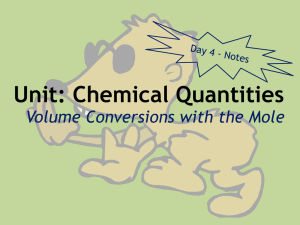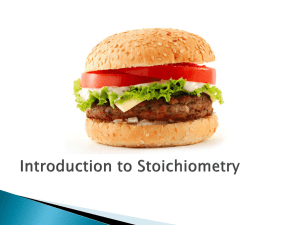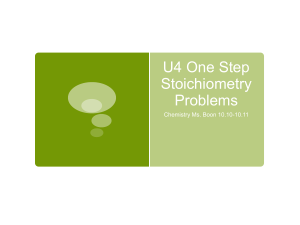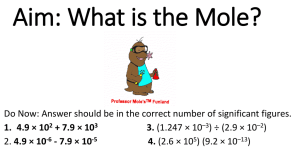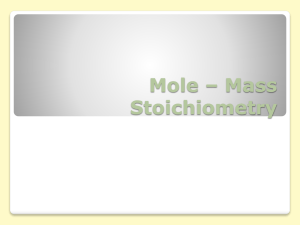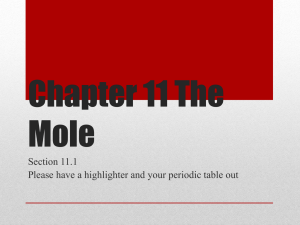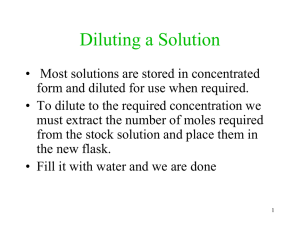moles
advertisement
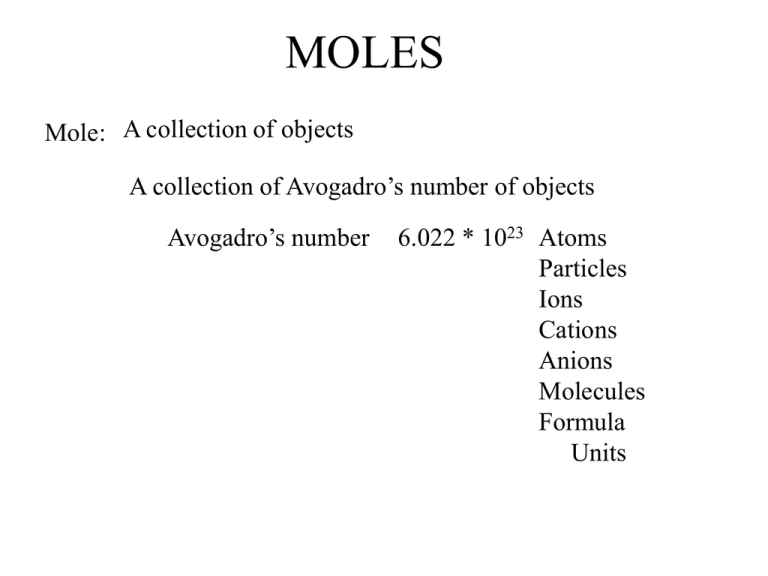
MOLES Mole: A collection of objects A collection of Avogadro’s number of objects Avogadro’s number 6.022 * 1023 Atoms Particles Ions Cations Anions Molecules Formula Units Mole Ratio The coefficient in front of each component in a balanced equation 2 Al (s) + 6 HCl (aq) ----- 2 AlCl 3 (aq) + 3 H2 (g) This states: 2 moles of Al reacts w/ 6 moles HCl to produce 2 moles AlCl3 and 3 moles H2 gas MOLE CALCULATIONS 1 mole Helium atoms One mole of helium atoms …. ….. is a number 6.022 * 1023 Helium atoms ….. has a mass 4.00 grams 1 mole Argon atoms One mole of argon atoms …. ….. is a number 6.022 * 1023 Argon atoms ….. has a mass 39.9 grams RECAP: 1 mol of “anything” contains 6.022*1023 “parts” Elements on p.table = I mol Molar mass (mass/1 mol) 1. Elements - decimal # on p.table Ti 47.87 amu or g 2. Molecules/Cmpd - sum of mass of all elements MOLES MASS Given mass, find moles How many moles are in 345.6 g NaNO3 ? Step 1: find formula wt. of NaNO3 1 Na = 23.0 g 1N = 14.0 g 3 O = 3 * 16.0 = 48.0 g 1 mole of NaNO3 = 85.0 g Step 2 : Find # of moles Use factor-label method Given * Conversion 345.6 g * 1 mole 4.07 moles NaNO 3 1 85.0 g 1 Given moles, find mass How many grams are in 0.6 moles N2O ? Step 1: find molecular wt. of N2O 2 N = 2 * 14.0 = 28.0 g 1O = 16.0 g 1 mole of N2O = 44.0 g Step 2 : Find mass Use factor-label method 0.6 moles * 44.0 g 26.4 g N O 2 1 1 mol MOLES NUMBER of PARTICLES Given moles, find # molecules How many molecules are in 1.6 moles oxygen? Step 1: Recognize that mass does not apply here. But Avogadro’s # is used Step 2 : Find # molecules Use factor-label method 1.6 moles * 6.02 *1023 molecules 9.63 * 1023 molecules O 2 1 1 mol Given # atoms, find moles How many moles are in 3.01 *1012 atoms of Chromium? Step 1: Recognize that mass does not apply here. But Avogadro’s # is used Step 2 : Find # moles Use factor-label method 3.01*1012 atoms * 1 mole -12 mols Cr 5.00 * 10 1 6.02 *1023 atoms MOLES MASS NUMBER of PARTICLES There is not a direct relationship between MASS and PARTICLES 2 Step Conversion Problem Will need to use MASS at some Given # formula units, find grams point in the problem How many grams are in 1.208 * 1024 formula units AgCl ? Step 1: find formula wt. of AgCl 1 Ag = 107.9 g 1 Cl = 35.5 g 1 mole of AgCl = 143.4 g Step 2 : Find moles Step 3 : Find mass Use factor-label method 143.4 g 1.208*1024 units * 1 mol * 288 g AgCl 1 6.02 *1023 units 1 mol Converts moles Converts formula units THEN to MASS to MOLES 2 Step Conversion Problem Will need to use MASS at some Given grams, find # atoms point in the problem How many atoms are in 128.0 grams of Mercury ? Step 1: find molar mass of Hg 1 mole of Hg = 200.6 g Step 2 : Find moles Step 3 : Find atoms Use factor-label method 128.0 g 1 mol 6.02 *1023 atoms * * 3.84*1023 atoms Hg 1 200.6 g 1 mol Converts mass Converts moles to MOLES THEN to ATOMS PROBLEM What is the formula weight of sodium carbonate, Na2CO3. This is an industrial chemical used in making glass. Also, equivalent to 1mole of a substance SOLUTION 2 * 23.0 = 2 Na 46.0 1 * 12.0 = 12.0 1C 3O 3 * 16.0 = 48.0 + 106.0 g BALANCE EQUATIONS “STOICHIOMETRY” Sodium Phosphate (aq) + Barium Nitrate (aq) ------ Barium Phosphate (s) + Sodium Nitrate (aq) 2 Na3PO4 (aq) + 3 Ba(NO3)2 (aq) ----- Ba3(PO4)2 (s) + 36NaNO3 (aq) Aluminum (s) + Hydrochloric Acid (aq) ----------> Aluminum Chloride (aq) + Hydrogen (g) 2 Al + 36HCl ---- 2 AlCl3 + 3 H2 MASS - MASS CALCULATIONS & LIMITING REAGENT (amts of 2 reactants given: limiting reactants) Solid calcium metal burns in air (oxygen) to form a calcium oxide cmpd. Using 4.20 g Ca & 2.80 g O2 how much pdt is made? Find 1) grams of pdt made from g of Ca 2) grams of pdt made from g of O2 3) limiting reagent 4) how much pdt can be made 5) % yield if 3.85 g produced PLAN: Need ------> balanced chem. rxn STEPS: g Ca -----> mols Ca -----> mols pdt ------> g pdt M g Ca coeff X pdt/Y react M g pdt (same steps converting oxygen) 2 Ca(s) + O2(g) -------> 2 CaO(s) M g Ca 40.1 g M g O2 32.0 g coeff X pdt/Y react Ca:CaO 2:2 O2:CaO 1:2 M g pdt 56.1 g 4.20 g 2.80 g X g 5.89 g 9.82 g 2 Ca(s) + O2(g) -------> 2 CaO(s) Mg: 40.1g Coeff : 2 mols : 0.105 1 0.0875 56.1 g 2 0.105 0.175 1 mol 2 molCaO 56.1g 1) 4.20 g Ca 0.105molCaO (0.105mol) 5.89g CaO 1 mol 40.1g 2 molCa 1 mol 2 molCaO 56.1 g 2) 2.80 g O2 0.175molCaO 0.175mol 9.82 g CaO 1 mol 32.0g 1 molO2 3) limiting reagent: Which produced the least amt-- Ca or O2? Ca ---> CaO = 5.89 g O2 ---> CaO = 9.82 g Ca, limiting reagent 4) how much pdt can be made: 5.89 g CaO 3.85 g actualam ount 100 65.4% 5) % yield= theoretical am ount 100 5.89 g RECAP: -- Balanced chem. equation -then, GIVEN USE FIND grams Molar Mass mols mols coeff mols mols Molar Mass grams limiting reagent: the reactant that produces the least amt of moles or mass of a specific pdt
